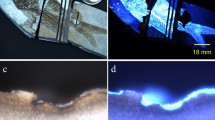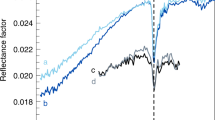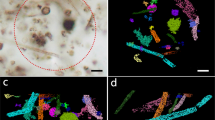Abstract
Unlike the familiar Phanerozoic history of life, evolution during the earlier and much longer Precambrian segment of geological time centred on prokaryotic microbes1. Because such microorganisms are minute, are preserved incompletely in geological materials, and have simple morphologies that can be mimicked by nonbiological mineral microstructures, discriminating between true microbial fossils and microscopic pseudofossil ‘lookalikes’ can be difficult2,3. Thus, valid identification of fossil microbes, which is essential to understanding the prokaryote-dominated, Precambrian 85% of life's history, can require more than traditional palaeontology that is focused on morphology. By combining optically discernible morphology with analyses of chemical composition, laser–Raman spectroscopic imagery of individual microscopic fossils provides a means by which to address this need. Here we apply this technique to exceptionally ancient fossil microbe-like objects, including the oldest such specimens reported from the geological record, and show that the results obtained substantiate the biological origin of the earliest cellular fossils known.
This is a preview of subscription content, access via your institution
Access options
Subscribe to this journal
Receive 51 print issues and online access
$199.00 per year
only $3.90 per issue
Buy this article
- Purchase on Springer Link
- Instant access to full article PDF
Prices may be subject to local taxes which are calculated during checkout



Similar content being viewed by others
References
Schopf, J. W. in The Proterozoic Biosphere, A Multidisciplinary Study (eds Schopf, J. W. & Klein, C.) 587–593 (Cambridge Univ. Press, New York, 1992).
Schopf, J. W. & Walter, M. R. in Earth's Earliest Biosphere, Its Origin and Evolution (ed. Schopf, J. W.) 214–239 (Princeton Univ. Press, Princeton, 1983).
Mendelson, C. V. & Schopf, J. W. in The Proterozoic Biosphere, A Multidisciplinary Study (eds Schopf, J. W. & Klein, C.) 865–951 (Cambridge Univ. Press, New York, 1992).
Schopf, J. W. in The Proterozoic Biosphere, A Multidisciplinary Study (eds Schopf, J. W. & Klein, C.) 25–39 (Cambridge Univ. Press, New York, 1992).
Schopf, J. W. Microfossils of the Early Archean Apex chert: new evidence of the antiquity of life. Science 260, 640–646 (1993).
Buick, R. Carbonaceous filaments from North Pole, Western Australia: are they fossil bacteria in Archean stromatolites? Precambrian Res. 24, 157–172 (1984).
Awramik, S. M., Schopf, J. W. & Walter, M. R. Carbonaceous filaments from North Pole, Western Australia: are they fossil bacteria in Archean stromatolites? A discussion. Precambrian Res. 39, 303–309 (1988).
Buick, R. Carbonaceous filaments from North Pole, Western Australia: are they fossil bacteria in Archean stromatolites? A reply. Precambrian Res. 39, 311–317 (1988).
Hayes, J. M., Des Marais, D. J., Lambert, I. B., Strauss, H. & Summons, R. E. in The Proterozoic Biosphere, A Multidisciplinary Study (ed. Schopf, J. W. & Klein, C.) 81–134 (Cambridge Univ. Press, New York, 1992).
House, C. H. et al. Carbon isotopic composition of individual Precambrian microfossils. Geology 28, 707–710 (2000).
Kudryavtsev, A. B., Schopf, J. W., Agresti, D. G. & Wdowiak, T. J. In situ laser–Raman imagery of Precambrian microscopic fossils. Proc. Natl Acad. Sci. USA 98, 823–826 (2001).
Schopf, J. W. & Fairchild, T. R. Late Precambrian microfossils: a new stromatolitic microbiota from Boorthanna, South Australia. Nature 242, 537–538 (1973).
Barghoorn, E. S. & Tyler, S. A. Microorganisms from the Gunflint chert. Science 147, 563–577 (1965).
Walsh, M. M. & Lowe, D. R. Filamentous microfossils from the 3,500-Myr-old Onverwacht Group, Barberton Mountain Land, South Africa. Nature 314, 530–532 (1985).
Schopf, J. W. & Packer, B. M. Early Archean (3.3-billion to 3.5-billion-year-old) microfossils from Warrawoona Group, Australia. Science 237, 70–73 (1987).
Tuinstra, F. & Koenig, J. L. Raman spectra of graphite. J. Chem. Phys. 53, 1126–1130 (1970).
Williams, K. P. J., Nelson, J. & Dyer, S. The Renishaw Raman Database of Gemological and Mineralogical Materials. (Renishaw Tranducers Systems Division, Gloucestershire, England, 1997).
McMillan, P. F. & Hofmeister, A. M. Infrared and Raman spectroscopy. Rev. Mineral. 18, 99–159 (1988).
Acknowledgements
We thank M. Walsh for loan of the Kromberg specimens; The Natural History Museum, London, for loan of the Apex specimens; and J. Shen-Miller for manuscript review. This work was supported by grants from the JPL/CalTech Astrobiology Center (to J.W.S.) and from the National Aeronautics and Space Administration Exobiology Program (to T.J.W.). A.D.C. is an NSF predoctoral Fellow. The Raman imaging facility at the University of Alabama at Birmingham is a consequence of the vision of L. DeLucas.
Author information
Authors and Affiliations
Corresponding author
Rights and permissions
About this article
Cite this article
Schopf, J., Kudryavtsev, A., Agresti, D. et al. Laser–Raman imagery of Earth's earliest fossils. Nature 416, 73–76 (2002). https://doi.org/10.1038/416073a
Received:
Accepted:
Issue Date:
DOI: https://doi.org/10.1038/416073a
This article is cited by
-
Silicified Microorganisms and Microorganism-Like Particles in the Groundwater of an Abandoned Coal Mine
Mine Water and the Environment (2023)
-
A re-classification of Precambrian cherts: implication on diagenetic origin of chert concretion, nodule and geode
Journal of Sedimentary Environments (2023)
-
Microbial biosignature preservation in carbonated serpentine from the Samail Ophiolite, Oman
Communications Earth & Environment (2022)
-
Biofinder detects biological remains in Green River fish fossils from Eocene epoch at video speed
Scientific Reports (2022)
Comments
By submitting a comment you agree to abide by our Terms and Community Guidelines. If you find something abusive or that does not comply with our terms or guidelines please flag it as inappropriate.



